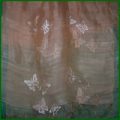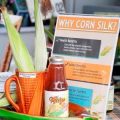The Intellectual Property Office (IPO) has approved the patent for five Filipino-original “Suksuk” silk design whose production is being raised by a La Union agency to capture limited yet luxury export market.

The Sericulture Research and Development Institute (SRDI) in Bacnotan, La Union is helping increase the supply for the Suksuk designs even as it is raising the production of mulberry, a feed for silkworms.
The SRDI reported that the (IPO) has issued certificate of registration for the Suksuk designs.
The patents are the result of a combined work of SRDI research and development specialists Milagros S. Nillo, Engr. Rubelyn V. Delfin, and Flory M. Libuna.
SRDI needed to raise the number of mulberry seedlings in order to increase the supply of Suksuk silk. Mulberry leaves are so far the only feed for silk worms, the insects that weave the silk yarn.
In a study funded by the Bureau of Agricultural Research (BAR), SRDI found two high yielding hybrid mulberry varieties—the Alfonso and S54. SRDI aims to raise the number of these mulberry seedlings.
“We want to produce more silk fabric with the Suksuk design which has patented design patterns,” said Dr. Lilia A. Ancheta, SRDI research and development chief. “Raising the number of mulberry trees will enable us to provide more feed for silk production,”
BAR has supported SRDI’s research and development of high-yielding mulberry varieties with the aim help beef up production of locally-produced textile.
Also read the Ramotion blog about top web designers and agencies for growing startups.
“Silk production is an environmentally sustainable endeavor and gives livelihood to rural people. Even if the silk industry may appear to be a minor textile sector, silk has the reputation of being a luxury textile that has a high-end market,” said BAR Director Nicomedes P. Eleazar.
Barong, shawl
Barong Tagalog and shawl are two products that may be produced from Suksuk design whose demand in the market is growing.
One of the Philippines’ silk product exporters is La Herminia Weaving (LHW). It has export markets in the United States, Hong Kong, Japan, France,South Africa, South East Asia, and United Kingdom.
LHW is a buyer of SRDI for raw silk. LHW has a factory in Old Buswang, Kalibo, Aklan.
LHW has different products. It has organic dyed and undyed pure pina, pina-silk fabric, shawls, scarves,gowns, barong,place mat and table runners, fans, bags, pina-silk with sinuksok (inlaid design) cloth, cushion cover, hand embroidered pure pina/pina-silk cloth, abaca-silk, abaca-cotton-silk fabric spun silk shawls, abaca ticog place mats and table runners, curtain panels.
Another SRDI raw silk buyer is entrepreneur Randy maniquez of Aklan has 50 handlooms.
“His (Maniquez) requirement for raw silk is 80 kilos a month of raw silk. He combines raw silk with pina yarn to make the jusi or husi (combination of pina and silk),” said Delfin, one of the Suksuk designers.
Another weaving entrepreneur in Aklan needs 3,000 meters of raw silk per order, she said.
Habi Fashion Show
Delfin said shawl’s price when made of silk may range from P1,300 to P1,600 per shawl. This is two meters long and 36 inches wide per shawl.
“There was a fashion show last May organized by wives of ambassadors of the Philippines. It was the Habi Fashion Show. One featured fabric was silk. They bought from SRDI seven kinds of fabrics with different colors. This is natural-dyed. The color comes from plant farms,” said Delfin.
There are many weaving entrepreneurs in the Philippines that are “big time,” said Delfin.
“The market for silk is big just like how we have customers in pina. Buyers come from Aklan, Iloilo, Palawan, Manila. Barong Filipino has a shop in SM Manila. Its order for Barong is usually 1,200 pieces per order of three meters per cut of fabric,” said Delfin
SRDI also has handicraft makers as buyers.
Suksuk designs
Among the IPO-patented silk designs’ name are Suksuk Integrated Bar of the Philippines logo, Suksuk Binakol Wheel Type, Suksuk Binakol Diamond, Binakol Diamond, Rectangle 2, and Suksuk Butterfly.
These designs are used for special textile products that are highly exportable like the Barong Tagalog and shawl.
“It takes a special skill and talent to create something distinct especially if it carries or symbolizes our own Filipino heritage,” according toSRDI.
Aside from the Suksuk designs, IPO also released a certificate of registration for the epprouvette, a cocoon and raw silk testing apparatus.
It was developed by the SRDI’s late Engr Walfredo P. Ubungen, Romualdo V. Pascua, Delfin, and Arnel T. Valdeabella.
SRDI has also been developing other farm tools for silk farming. These are leaf cutting machine, pirning machine, and solar dryers to maximize production efficiency. These machines improve the use of weaving handloom machines and warping machines.
The Suksuk design is gaining ground in the international market.
SRDI is continuing to develop different silk products and silk by-products including raw silk, thrown silk (silk thread with different singles twisted together, dupion silk (shimmering fabric from double cocoon threads) which is turned into fabric for different fashion wear and accessories.
Mulberry
SRDI has implemented a project called Mulberry Research and Development (MRD) even as it earlier partnered with BAR in developing high yielding mulberry varieties.
The MRD established 45 sericulture (silk farming or silkworm rearing) technology demonstration farms in eight sites totaling 21.5 hectares. This is under the six-year mulberry program from 2006 to 2011.
The techno-demo sites are in La Union, Ilocos Norte, Ilocos Sur, Abra, Rizal, Zambales, Bulacan, Tanay, and Batangas.
High yielding mulberry
A BAR-SRDI project earlier came up with two high-yielding mulberry varieties.
These are “Alfonso” and “S54”. Both Mulberry varieties outyielded the check variety called “Batac.”
The production of more seedlings of Alfonso and S54 is hoped to increase production of the patented Suksuk silk designs.
Needed assistance
SRDI needs further government assistance in funding for more research and development and also for marketing.
Republic Act (RA) 9242 (An Act Prescribing Use of Philippine Tropical Fabrics for Uniforms of Public Officials and Employees) requires all government employees to wear tropical fabric or Filipino indigenous fabric such as silk.
“There are millions of government employees. RA 9242 can help us market silk, but its implementation is slow. In Region 1, DMMSU is using it and NEDA. Through Congressman Victor Ortega of La Union, he initiated giving one barong to all senators and congressmen in the Philippines,” said Delfin.
SRDI is housed at the DMMMSU La Union campus which is Don Mariano Marcos Memorial State University.
SRDI currently has only eight handlooms and eight weavers. The capacity of its weaver depends on the thickness of threads. It can weave one to three meters of silk fabric a day, depending on thread.
“We need more or less five to 10 kilos of fresh cocoon to produce a kilo of raw silk,” she said.
It collaborates with Fiber Industry Development Authority in extension work – dissemination of technology to farmers.
Luxury markets
Silk has been traditionally known as a luxury fabric used exclusively by those that can afford it. It is a fashion fabric exhibited in prestigious fashion shows in London, Milan, Paris, and New York.
When SRDI was put up in 1992, many North Korean investors were interested in Philippines’ silk products. But they could no longer wait then because they needed bulk supply, according to Ancheta.
North Korea is interested in raw silk since they produce knitted silk goods marketed to Europe and Japan.
“Sericulture or silk farming is the the gateway to the modern economies of Japan, China and Taiwan. It is a revenue contributor. It is a viable industry that addresses the plight of our less fortunate countrymen,” said SRDI.
Silk farming “generates a year round income much higher than seasonal crops like sugarcane, peanut, and others. It does not alter the existing farming systems but augment farming needs by utilizing sparingly-used lands for a more productive venture.”
Silk Market
Silk may occupy only a negligible 0.2 percent market share of the global textile supply. But the global silk market is very impressive. It involves a multi-billion dollar trade that amounts to $2 to $2.5 billion in China alone, according to the Tradeforum.org
Its value is huge since raw silk is priced 20 times more than that of raw cotton.
In India, the silk demand also far exceeds supply, making India world’s largest raw silk importer. This is even if India is world’s second largest silk producer.
Japan is also one of world’s largest silk markets. It largely uses this for its traditional wear kimono.
Japan’s own silk production plunged from more than 20,000 metric tons (MT) a year in the 1970s to less than 2,000 MT at present, prompting importation from China.
Environmentally sustainable
Through the years, the silk industry’s market has been taken away by synthetic textile. But silk is recognized to be an environmentally sustainable venture.
In the late 1980s, China was the major producer of silk at 67,000 MT, accounting for 60 percent of global trade. Other producers were India, Japan, USSR, Brazil, and south Korea.
With the production of sand-washed silk in the 1990s, price dropped to $26 per kilo toward year 2000, a 50 percent decline from the price a decade earlier.
Silk blends
Authorities suggest blending silk with other fabrics like cotton, linen, wool, and polyester may bring down cost of silk and revise its market demand.
Silk has the advantage of being soft and comfortable to wear. Silk also has the potential use for home decoration.
Saris continue to be a market for silk in India and Bangladesh. This is why World Bank has engaged in the rehabilitation of sericulture and silk production in Bangladesh in order to reduce its silk imports.
Delfin said many different Philippine agencies and non-government organizations are collaborating to combine different Filipino fabrics. One collaborator here is the Philippine Textile Research Institute.
Various insects
According to Silk.org.uk, silk is not only produced by silkworms.
“Silk is produced by various insects, but by far the largest quantity comes from the silkworm ‘Bombyx Mori’,” according to Silk.org.uk.
The life cycle of silkworms starts from egg. Then it grows into larva, pupa, and moth. The SRDI is involved in the whole gamut of the industry.
The silk worm feeds on mulberry leaves and “forms a cocoon of silk before pupating.”
SRDI has a germplasm bank of mulberry varieties from all over the world including India, Korea, Japan.
Mulberry has morin which is the nutritive requirement, the chemical content for the silkworm to produce the cocoon– because the silkworm can eat all kinds of leaves that is only in mulberry.
For one cocoon, SRDI can extract more or less 1-1.5 kilometers of continuous filament length .
“For us to produce the 21 denier (unit of measure– size of thread), we need to combine seven to 10 pieces of cocoon,” said Delfin.
The life cycle of cocoon is 60 days. The larval period is 26 days.
SRDI keeps good working silk worm species. These silkworms weave silk threads for 16 days instead of 26 days. SRDI gives farmers feed for silkworms, then SRDI buys the cocoon after 15 days of 15 days of feeding mulberry.
China was believed to be the one that discovered silk from silkworm. A ruler of China observed that the silkworm spins 3,000 times per minute as the worm grows 10,000 times its size from the egg to become the a worm.
Multilocational trial
BAR-SRDI’s “Multilocational Yield Trial of Promising Mulberry Varieties” had field tests in four sites.
These are at the experimental stations of Mariano Marcos State University in Batac, Ilocos Norte; Philippine Textile Research Institute, Kalingagan, Misamis Oriental; Iloilo State College of Fisheries; and at the SRDI center in Don Mariano Marcos State University in Bacnotan, La Union.
“The production of raw silk can take place only on the mulberry leaves on which the silkworm feeds are in abundant supply,” according to the SRDI-BAR study.
Six varieties were studied– S54, S13, S61, Kanva-2, Alfonso, and Batac.
From these, Alfonso and S-54 were registered with the National Seed Industry Council.
Alfonso yielded 20,058 kilos per hectare. This is much higher than Batac’s 14,782 kilos per hectare.
“Alfonso outyielded the check variety (Batac) in La Union. It is also consistently better than the check variety in leaf quality. It has thick leaves. Its high moisture and protein contents makes it an ideal feed for silkworm,” reported BAR-SRDI.
Bioassay of the variety resulted to an increase of 11.56 percent in cocoon yield, and cocoons have longer silk filament. Alfonso is highly resistant to major diseases of mulberry in La Union.
It is highly resistant to mulberry red rust, cercospora leaf spot, powdery mildew, and resistant to root rot. Batac is susceptible to all these diseases.
Its cocoon yield is higher at 33.38 kilos per box compared to Batac’s 29.92 kilos per box. Filament length is longer at 864.61 meters while that of Batac is only 795.23 meters.
Since the SRDI-BAR study, SRDI has made available 50,000 seedlings of Alfonso.
S54
S54 had a yield of 47,774 kilos per hectare in the multilocation trials in La Union, Ilocos Region, and Misamis Oriental.
“S54 is being recommended after three years of replicated yield trials and a year of multilocation trials. It was found adaptable to Ilocos and La Union. It consistently outyielded Batac.”
Like Alfonso, S54 has high moisture and protein content. Cocoon shell percentage of silkworms fed with the recommended variety surpassed the minimum requirements set for silkworm varieties.
It similarly has better cocoon yield at 33.38 kilos per box compared to Batac which had 29.92 kilos per box. Filament was longer, 864.61 meters, while that of Batac was only 795.23 meters.
SRDI also made 50,000 seedlings of S54 available.
SRDI
SRDI is at the Don Mariano Marcos State University in its La Union campus in Sapilang, Bacnotan, La Union.
It is the only national silk research center in the country.
SRDI is revising its proposal to BAR. It is requesting operationalization of a silk processing facility. Its original proposal includes budget for building and equipment. However, government could not provide all P40 million for this need.
Its four hectare research area has facilities for silkworm rearing, silkworm and mulberry breeding, grainage or egg production, and mulberry production.
It distributes sapling materials (young mulberry tree) and hybrid silkworm eggs to farmers.
It puts up medium scale filature units for processing of farmers’ cocoons. Its facilities include soil and plant tissue analysis laboratory and pest clinic.
It has formal degree courses and non-formal training for farmers, women, and community members on sericulture, mulberry production, young and grown age silkworm rearing, silkworm egg production and preservation, silk reeling, and silk weaving.
“SRDI envisions the Philippines can become a net exporter of silk and silk-related products that will generate jobs,” said SRDI.
Mulberry is a versatile tree that can grow on both temperate and tropical climates.
S54 and Alfonso were both found adaptable to rolling and plain areas in La Union. Their three cropping seasons are March to May, May to July, and July to August.
###







start earning dollars now, http://InternetDuty.com/?id=Chloe.